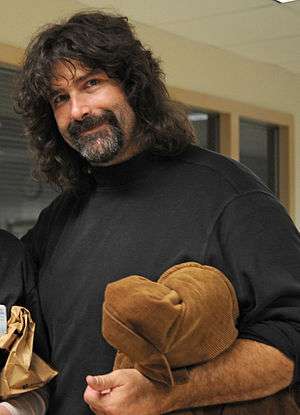Attitude Era
The Attitude Era is a term used by World Wrestling Entertainment (WWE, then known as World Wrestling Federation or WWF), to describe the company's programming during the Monday Night Wars, a period in which WWF's Monday Night Raw went head-to-head with World Championship Wrestling's (WCW) Monday Nitro in a battle for Nielsen ratings each week during the late 1990s and early 2000s. WWF's programming, branded as "WWF Attitude" from 1997 to 2002, featured adult-oriented content, which included an increase in the level of depicted violence, profanity and sexual content. This era was part of a wider surge in the popularity of professional wrestling in the United States and Canada as television ratings and pay-per-view buy-rates for WWF and its rival promotions saw record highs.

The Attitude Era marked the rise of many WWF male singles wrestlers, including Stone Cold Steve Austin, The Rock, Mick Foley (in various personas), The Undertaker, Triple H, and Kane.[1] The Steve Austin-Vince McMahon rivalry marked the central feud throughout the era, with Austin labeled as the poster boy of the era.[2] The WWF Women's Championship, which lay dormant since 1995, was reactivated in September 1998. While most of the company's female talent such as Sable, Sunny and later Trish Stratus and Stacy Keibler during this time period were marketed as sex symbols and often booked in sexually provocative gimmick matches (for example "bra and panty" matches, bikini matches, etc) in an effort to draw more male viewership, prominent female stars such as Chyna, Lita, Ivory, and Jacqueline among others were presented as legitimate wrestlers in legitimate wrestling matches. It was also the resurgence of tag team wrestling, namely The Hardy Boyz, The Dudley Boyz, and Edge & Christian who were featured in several destructive, physical and stunt-filled Tables, Ladders and Chairs matches during this era. Distinguished stables established in this era, such as D-Generation X, The Nation of Domination, The Corporation, The Ministry of Darkness, The Corporate Ministry and The Brood among others developed major rivalries among each other.[3]
Initiation
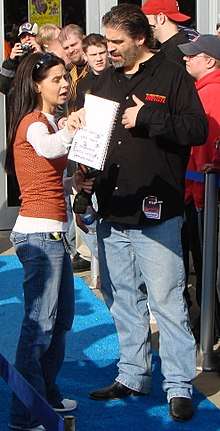
During the Monday Night Wars — a ratings battle between WWF's Monday Night Raw and WCW's Monday Nitro — the WWF transformed itself from a long history of family-friendly programming into a more adult oriented product. The creative side of the product during the early stages of the era was spearheaded by Chairman Vince McMahon and head writer Vince Russo, who drastically changed the way professional wrestling television was written. Russo's booking style was often referred to as Crash TV — short matches, backstage vignettes, and shocking angles. While the WWE Network describes the December 15, 1997, episode of Raw Is War as being the first from the Attitude Era, WWE themselves have stated that Survivor Series 1997, which took place over a month beforehand, marked the beginning of the era.[4] They have also said that King of the Ring 1996,[5] and WrestleMania XIV on March 29, 1998,[6] were the starting point.
Several miscellaneous events outside the major benchmarks have been credited with helping transition to the Attitude Era. A few years after the Hulkamania era, WWF needed more sales. In his book, Russo mentions the debut of the character Goldust in 1995 as a turning point. Goldust portrayed an androgynous wrestler was also viewed as a shift to a more adult oriented product.[7][8] Brian Pillman's "loose cannon" persona and the "Pillman's got a gun" segment from 1996 when he pulled a gun on Austin, has also been credited. By 1996, WWF had also begun playing up female sexuality, led by Sunny and Sable.[9] After losing a steel cage match against Sycho Sid in an attempt to win back the WWF World Heavyweight Championship in March 1997, Bret "Hitman" Hart angrily shoved McMahon to the wrestling mat and went into a profanity-laced tirade.[10][11]
Birth of Austin 3:16
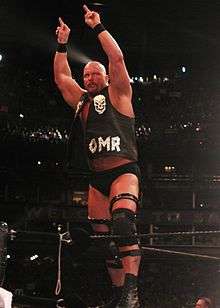
Stone Cold Steve Austin, who previously wrestled in WCW and Extreme Championship Wrestling (ECW), first appeared in WWF in 1996 as "The Ringmaster" and was managed by Ted DiBiase.[13] For several months, Austin held the Million Dollar Championship while DiBiase served as his mouthpiece. When DiBiase left WWF following a stipulation on a "Caribbean Strap Match" between Austin and Savio Vega, Austin revealed that he purposely lost the match to rid himself of the distractions caused by DiBiase.
The 1996 King of the Ring tournament saw Austin's first usage of "Austin 3:16", the major marketing juggernaut for WWF during the era.[14] After winning the tournament by defeating Jake "The Snake" Roberts, Austin mocked Roberts' recital of the biblical passage John 3:16 by saying, "You sit there and you thump your Bible, and you say your prayers, and it did not get you anywhere! Talk about your Psalms, talk about John 3:16... Austin 3:16 says I just whipped your ass!"
Austin's popularity gradually started to rise as an anti-hero despite his playing a heel character, eventually leading to a long feud with Hart from late-1996 to mid-1997 climaxing in a Submission Match at WrestleMania 13. In 1997, a storyline involving Owen Hart and Austin culminated in Austin performing a Stone Cold Stunner on Vince McMahon to a positive crowd response and leading to Austin's arrest.[15] This laid the foundation for the later feud between Austin and McMahon, one of the central storylines of the Attitude Era.
Bret Hart and Shawn Michaels
.jpg)
Another storyline from 1996 to 1997 was the feud between Hart and Shawn Michaels, who had legitimate issues with one another outside of wrestling. The conflict behind the scenes spilled out into their on-screen storyline, where both men made pointed personal remarks in interviews and promo segments that were often rooted in these issues.[16]
On one episode of Monday Night Raw, Michaels went on a tirade against Hart and appeared to break kayfabe when he said: "Because Bret, believe me, you couldn’t go 10 minutes in any situation, if you know what I mean. Even though lately you’ve had some 'Sunny days' my friend, you still can’t get the job done".[17] Michaels' comments insinuated that Hart was having an affair with Sunny, even though she in fact had a legitimate affair with Michaels which lasted nine months.[18] The comments began causing marital problems for Hart, which eventually led him to a heated backstage confrontation with Michaels.[19]
Their rivalry culminated in the Montreal Screwjob, one of the most critical points in the birth of Vince McMahon's character, Mr. McMahon, a corrupt evil-owner caricature fixated on destroying the lives of disobedient employees.
Stone Cold Steve Austin
Mike Tyson and WrestleMania XIV
After Austin won the 1998 Royal Rumble,[20] former boxing champion Mike Tyson made a guest appearance on Raw Is War the following night. Tyson, who at the time was still suspended from boxing, was to be introduced as the "Special Guest Enforcer" referee for the championship match at WrestleMania XIV. However, McMahon's presentation of Tyson was interrupted by Austin, who flipped off Tyson, leading to a brief scuffle. Over the following weeks, Tyson aligned himself with Michaels, Austin's opponent at WrestleMania, and D-Generation X.
In the closing moments of the match, Tyson counted Austin's pinfall on Michaels. Following the victory, a distraught Michaels confronted Tyson, who then knocked out Michaels with a right-handed punch as Austin celebrated.[21] Tyson was paid $4 million for his role.[22]
The Austin vs. McMahon rivalry
One of the most important rivalries during the Attitude Era was the Austin vs. McMahon storyline, where Austin, the company's defiant top star, would have to overcome the odds stacked against him by Mr. McMahon. Mr. McMahon, who did not want Austin to be the WWF Champion, would stop at nothing to put an end to Stone Cold, and Austin would do anything to beat Vince. On the Raw after Austin won the WWF Championship, Mr. McMahon presented him with the newly designed WWF Championship belt and informed him he did not approve of his rebellious nature and that if he did not conform to society and become his image of what a WWF Champion should be, Austin would face severe consequences. Austin gave his answer in the form of a Stone Cold Stunner to McMahon. This led to a segment a week later where Austin had pledged a few days prior in a meeting to agree to McMahon's terms, appearing in a suit and tie, with a beaming McMahon taking a picture of himself and Austin, his new corporate champion. The entire thing was a ruse by Austin, who in the course of the segment proceeded to tear off the suit, telling McMahon it was the last time he'd ever be seen dressed like this. Austin punched McMahon in the 'corporate grapefruits' and took another picture with McMahon writhing in pain.
The following week on April 13, 1998, Austin and McMahon were going to battle out their differences in an actual match, but the match was declared a no contest when Mick Foley (as Dude Love) interrupted the entire contest. On that night Raw defeated Nitro in the ratings for the first time since June 10, 1996.
Their rivalry continued throughout the Attitude Era, bringing increased revenue and attention to the company. The rivalry got more intense as time went on, with McMahon trying to sabotage Austin whenever he could to stop him from being the WWF Champion. Austin often exacted revenge on McMahon, such as attacking McMahon with a bedpan while he was in the hospital, stealing a cement mixer and driving it into the arena, then filling up one of McMahon's Corvette cars with cement,[23] driving a Zamboni to the ring before attacking McMahon leading to Austin's arrest once again,[24] kidnapping Vince in a wheelchair, wheeling him down to the ring at gunpoint which ended up actually being a toy gun with a scroll that reads "Bang 3:16!" which frightened McMahon so much he urinated himself, or driving a beer truck to the ring and using a fire hose to spray Vince, Shane McMahon and The Rock with beer. Austin wrestled McMahon in 1999 at St. Valentine's Day Massacre in a steel cage, which he won when the debuting Big Show accidentally threw him through the cage wall, thus earning a world title shot at WrestleMania XV. Through the rivalry, McMahon founded two heel factions: The Corporation and The Corporate Ministry, using several wrestlers to face Austin, including The Rock, The Undertaker, Kane and Big Show.
The Rock
Dwayne Johnson, a third-generation wrestler, made his debut at the 1996 Survivor Series as "Rocky Maivia", naming himself after his grandfather Peter Maivia and his father Rocky Johnson. Despite being a babyface with an impressive winning streak and an Intercontinental Championship reign, he was frequently met with negative reception from live audiences: loud boos, "Rocky sucks!" chants, and even crowd signs that read "Die Rocky Die".
Nation of Domination
.jpg)
Maivia joined the Nation of Domination in 1997 and renamed himself "The Rock", an egotistical jock who referred to himself in third person and often cut colorful promos insulting rival wrestlers as well as fans who did not support him. As a member of the Nation of Domination, The Rock won the Intercontinental title for a second time. The Rock eventually overthrew Faarooq to become the leader of the Nation.
The People's Champion
After the Nation disbanded, The Rock referred to himself as the "People's Champion" and began to receive the support of the audience, which led Vince McMahon and the Corporation to target him. After battling McMahon's goons for the chance to go to the Survivor Series, the Rock entered the tournament and made it to the finals against McMahon's chosen representative, Mankind. Survivor Series 1998 was the first PPV headlined by The Rock. During the match, a double turn occurred with the help of McMahon, similar to the previous year's Survivor Series, revealing that Rock was working with The Corporation all along. The Rock officially joined McMahon as the crown jewel of The Corporation, abandoning his previous moniker as "The People's Champion" and declaring himself "The Corporate Champion".
The Corporation
As a member of The Corporation, The Rock's persona changed yet again, to an even more callous attitude. The Rock had a lengthy feud with Mankind, with a rematch at Rock Bottom, where Rock retained the title due to a technicality, even though he lost the match. Mankind, however, won the title on Raw Is War. The reign was short lived, as the Rock got his rematch at the 1999 Royal Rumble, in an I Quit Match. The Rock won the I Quit Match and became the WWF Champion yet again. A rematch, known as "Half-Time Heat", took place during halftime of the Super Bowl, and Mankind won the match and the title, after pinning the Rock underneath a forklift. The Rock got a rematch at St. Valentine's Day Massacre, in a last man standing match for the chance to headline WrestleMania XV as the WWF Champion. The bout ended in a draw after both men were unable to stand at the ten count. Despite Mankind being the WWF Champion, he gave the Rock one more shot at the title in a ladder match on Raw. This was their final match, as the Big Show interfered in the match and chokeslammed Mankind off the ladder, leaving the Rock all by himself to win the match and headline WrestleMania XV as WWF Champion.
At WrestleMania XV The Rock, the WWF Champion faced off against the challenger, Stone Cold Steve Austin. Vince McMahon interfered in the match attacking Stone Cold to try and stop him but was unsuccessful. Austin won the match and seemingly defeated The Corporation and McMahon. Austin, after winning the title, described the belt as not being good enough, using his personalized Smoking Skull Belt. McMahon, who was in possession of the belt, ordered Shane McMahon to give it to Austin, seemingly ending their feud. But Shane had other plans, as he went against his father's wishes and gave the belt to The Rock. This was the basis for The Rock's rematch at Backlash for the WWF Championship. In order for Stone Cold to reclaim his Smoking Skull belt, he had to defeat the Rock at Backlash. With the WWF Championship on the line, The Rock lost the rematch and the Smoking Skull belt. The night after Backlash, after failing to beat Austin for a second time, Shane McMahon turned on The Rock and fired him from the Corporation.
Return as The People's Champion
After being fired from the Corporation, The Rock once again declared himself the People's Champion and went on a number of small feuds during the latter part of 1999. It was during this time The Rock's popularity began to flourish once again, and he joined his former rival Mankind to create the tag team, The Rock 'n' Sock Connection. The team won the WWF Tag Team titles. After the Rock 'n' Sock connection broke up, The Rock went back into the main event picture of the WWF, battling the likes of Triple H and his stable, the McMahon-Helmsley Faction. Late in the Attitude Era, The Rock faced Stone Cold Steve Austin again at WrestleMania X-Seven for the WWF Championship. Stone Cold once again defeated The Rock to regain the title and also joined forces with his nemesis Mr. McMahon.
The Undertaker
The Undertaker was one of only a handful of top performers who never left the WWF before and during the Monday Night Wars. His gimmick, a horror-themed, macabre entity who employed scare tactics and held links to the supernatural, allowed the WWF to push the envelope from a creative perspective during this era.
The Brothers of Destruction
At SummerSlam in 1996, The Undertaker became embroiled in a feud with his former manager Paul Bearer. During the course of their conflict, Bearer threatened The Undertaker with the threat of revealing his 'secret', calling him a "murderer" and accusing him of killing his parents and brother. In the following weeks on Raw, Bearer revealed that his brother Kane was actually still alive. Kane debuted at Badd Blood: In Your House, wearing a mask and interfering in the Hell in a Cell match between Undertaker and Shawn Michaels. Following a series of taunts from Bearer and Kane, who cost him the WWF World Heavyweight Title at the Royal Rumble, he agreed to face Kane at WrestleMania XIV. The Undertaker won the match at WrestleMania and the first ever Inferno Match at Unforgiven. Following the conclusion of this storyline, The Undertaker and Kane united to form a tag team that became known as The Brothers of Destruction.
The Ministry of Darkness
.jpg)
In late 1998, The Undertaker turned on Kane and realigned himself with Paul Bearer. Now proclaiming himself as the "Lord of Darkness", he began taking a more macabre and darker persona, claiming that a "plague of evil" would hit WWF. During the weeks that followed, he reignited his feud with Stone Cold Steve Austin, whom he blamed for costing him the WWF title. At Rock Bottom: In Your House, Austin defeated the Undertaker in a Buried Alive match with the help of Kane, writing him off of WWF television for a month.
Upon his return, a much scarier, darker, druid-like Undertaker introduced his Ministry of Darkness, a satanic-themed stable which consisted of The Acolytes (Faarooq and Bradshaw), Mideon, Viscera and The Brood (Edge, Christian, and Gangrel). The storyline continued over the weeks that followed, as the Undertaker announced his intentions of taking over WWF and claimed he was working for a "higher power". He began a feud with Vince McMahon and his daughter Stephanie, with the Ministry burning Undertaker's symbol in the McMahon family yard.
At Backlash: In Your House on April 25, Mr. McMahon had Ken Shamrock face The Undertaker, but his plan backfired and Shamrock was attacked by Bradshaw after the match. Later, The Undertaker commandeered Stephanie's limo and drove off into the night with a screaming Stephanie in tow as Backlash went off the air. The Undertaker attempted to marry her the next night on Raw Is War by holding a "Black Wedding" for himself and Stephanie in a bid to take control of the company. The ceremony was successfully ruined by Steve Austin, after two attempts by Corporation members Big Show and Ken Shamrock failed.
The Corporate Ministry
On the very first ever episode of SmackDown!, The Undertaker joined forces with Shane McMahon, in turn gaining control of The Corporation and merging his Ministry with it to form The Corporate Ministry. The Undertaker, with the help of Shane, defeated Austin at Over the Edge 1999 and won the WWF Championship. However, after Mr. McMahon was revealed as its "Greater Power", The Corporate Ministry eventually dissolved.
The Undertaker formed a new "Unholy Alliance" with Big Show, Mideon and Viscera, which led to two WWF Tag Team Championship reigns for Big Show and Undertaker. This group came to an end when The Undertaker suffered a legit injury in September and was written out by quitting, rather than taking a match ordered by Mr. McMahon.[25]
Mick Foley
Mick Foley played three different personas during this era: Mankind, Dude Love and Cactus Jack. While Mankind was his main persona in WWF and Cactus Jack was previously used in his days in WCW, Japan and independent circuits, Dude Love was inspired by a character Foley created when he and his high school friends did backyard wrestling in his home area of Long Island, New York. Foley debuted both Dude Love and Cactus Jack in the WWF in mid-1997, while Mankind was debuted at Foley's first ever WWF event on April 1, 1996 during the Raw event right after WrestleMania 12. Foley's creative versatility allowed him to create distinct and different characteristics for each character and he would prepare for each role by putting himself in each character's respective comfort zone, much like an actor would when preparing for a role on film or stage. Although his general move-set stayed the same save for one or two moves that were used by each character, Foley would have different motions and even different catchphrases for each character (Cactus Jack: "Bang Bang!", Mankind: "Have a Nice Day!", Dude Love: "Owwww, Have Mercy!").
When developing the Mankind character he would spend whole nights under the wrestling ring or in that week's arena's boiler room. In addition, as he had been in his previous days in different wrestling circuits, Foley, the "Hardcore Legend" was often involved in the Attitude Era's most violent and dangerous matches, including hardcore matches that took place outside the ring and sometimes even involved sharp objects such as barbed wire, thumbtacks, broken glass and also various blunt objects- and most of Foley’s matches included at least one dangerous bump. The image of Foley being thrown and falling 20 feet from the top of the third Hell in a Cell match by The Undertaker at the 1998 King of the Ring is synonymous with the era, along with Jim Ross' commentary of "as God is my witness, he is broken in half!".
On January 4, 1999 on Raw Is War, he won his first WWF Championship from The Rock with the help of Stone Cold Steve Austin. This match is also known as the turning point in ratings of the Monday Night Wars as it favored WWF until the end of the wars and led to the downfall of WCW. That night, WCW attempted to sabotage Raw's rating by announcing the result of the match on Nitro, but their plan backfired when Nielsen ratings indicated that over 600,000 households changed the channel to watch the victory and shifted the ratings for the night in WWF's favor.[26][27]
Owen Hart
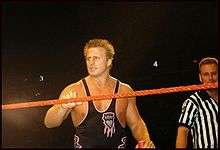
Near the beginning of the Attitude Era in late 1997, Bret Hart left WWF due to a contract dispute and joined WCW. He was soon followed by family members Jim Neidhart and Davey Boy Smith, leaving younger brother Owen Hart as the sole remaining member of the Hart Family employed by WWF. He remained off-camera during the tumult following the Montreal Screwjob and later reappeared using the nicknames "Black Hart" and "Lone Hart".
Owen Hart was aligned with the Nation of Domination for much of 1998, winning the European Title along the way. After the dissolution of the stable, Hart began teaming with Jeff Jarrett. In the storyline, Hart quit the WWF after accidentally injuring Dan Severn, but he quickly re-emerged as the joke character "The Blue Blazer", reprising a gimmick that Hart had employed early in his career.
Hart died on May 23, 1999 at the Over the Edge pay-per-view event. In an elaborate entrance routine that he had performed before, Hart (as The Blue Blazer) was to be lowered to the ring slowly from the rafters, with intent to perform a pratfall from a few feet above the ring. When the harness failed, Hart instead fell 78 feet into the ring, striking the top rope with his chest, leading to his death minutes later from internal bleeding as a result of blunt force trauma. The company made the controversial decision to continue the event to its completion after the incident. On the next evening's Raw Is War, all storylines were suspended and the entire show was presented as a tribute to Hart, with other superstars sharing their memories of him between exhibition matches.
The women's division
Sable
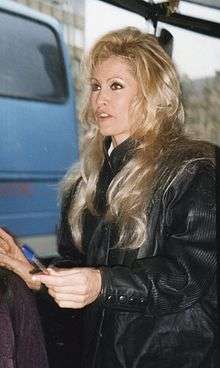
Sable made her World Wrestling Federation debut at WrestleMania XII in March 1996, escorting Hunter Hearst Helmsley to the ring as he took on the returning Ultimate Warrior. Sable's first major angle involved her then real-life husband, who debuted at WrestleMania XII as "Wildman" Marc Mero. Sable, however, quickly eclipsed both her husband and real-life rival Sunny in popularity, leading to the reinstatement of the WWF Women's Championship as well as the promotion's hiring of more female wrestlers. Sable became the first WWF female to refer to herself as a "Diva" during the April 19 edition of Raw Is War in 1999; the term would be coined and shortly thereafter becoming the official title for WWF's female performers, be they managers or wrestlers. . According to Stephanie McMahon, Sable's popularity led to a shift in the role of women in the WWF, as the promotion began to rely less on its female performers as mere eye candy and placed a greater emphasis on female athletes who actually competed in matches and storylines. Sable was one of the first females to compete in such specialty matches as evening gown matches, inter-gender tag team matches, and strap matches, competed in the first-ever WWF bikini contest against Jacqueline, and was also the first female talent to be a Playboy cover girl. Unlike Jacqueline, Ivory, Tori, and Luna, the more physical Divas and experienced wrestlers at the time, Sable later admitted that it was written in her contract that she was not allowed to take bumps. Despite not being allowed to take bumps, Sable is 3-0 at WrestleMania. Kevin Nash would later admit that rival promotion, WCW, were more concerned with Sable's appearance than the superstars.[28][29]
Lita
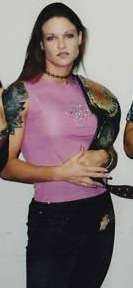
Lita made her WWF debut as a valet for luchador Essa Rios on the February 13, 2000 episode of Sunday Night Heat, where Rios was booked to win the WWF Light Heavyweight Championship from Gillberg.[30] During the match, Lita mimicked Rios' moves, notably the moonsault and hurricanrana. Lita eventually left Rios' side and allied with the Matt and Jeff Hardy, and the trio formed a stable known as Team Xtreme. As a member of Team Xtreme, Lita developed a more "alternative" image, wearing baggy pants with a thong, which was hiked up high above her pants, clearly exposed.[31] During her time with Team Xtreme, Lita became the only female to ever be physically involved in a Tables, Ladders, and Chairs match in WWF.[32]
In June 2000, Team Xtreme began a storyline with T & A (Test and Albert), with Lita engaging in a rivalry with their manager, Trish Stratus.[33] Lita also began a concurrent feud with WWF Women's Champion Stephanie McMahon-Helmsley, and they became the first two women to main event an episode of Monday Night Raw. On the August 21, 2000 episode of Raw, Lita defeated Stephanie to win the Women's Championship for the first time.[34] The match also featured The Rock as the special guest referee and constant interference from Triple H and Kurt Angle.[34]
D-Generation X
The night after WrestleMania XIV, Shawn Michaels began a four-year hiatus from in-ring wrestling to recuperate from a back injury. On-screen, Triple H claimed that he was taking over D-Generation X (DX) and had ejected the absent Michaels for "dropping the ball" over the Tyson incident and had recruited the New Age Outlaws ("Road Dogg" Jesse James and "Bad Ass" Billy Gunn) and X-Pac into the "DX Army". On April 28, 1998, Nitro was held at the Norfolk Scope in Norfolk, Virginia, while Raw was held nearby at the Hampton Coliseum in Hampton, Virginia. With the ongoing war between WWF and WCW, the DX Army decided to initiate an immediate "invasion" of Nitro. The DX Army drove to the Norfolk Scope in an army Jeep, challenging WCW head Eric Bischoff. Soon after, the DX Army appeared at CNN Center (as well as WCW's stand-alone Atlanta offices) to call out WCW owner Ted Turner. The stable's popularity continued to grow, and they were eventually pushed as antihero fan favorites, much like their contemporaries Stone Cold Steve Austin and The Rock. Chyna the sole female wrestler of the stable has been cited as most dominant female wrestler of all time and participated in several inter gender matches and is the only woman to have won the men's prestigious Intercontinental Championship.[35]
The McMahon-Helmsley Faction
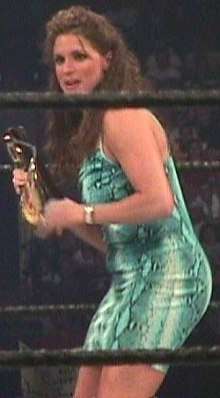
On the November 29, 1999 episode of Raw Is War, Stephanie McMahon was set to marry Test, but Triple H interrupted the ceremony. He played a video on the titantron showing himself marrying a drugged Stephanie at a drive-through chapel in Las Vegas. This led to a match at Armageddon between Triple H and Mr. McMahon with the stipulations being that if Triple H won, he would receive a WWF Championship title shot on Raw Is War, whereas, if Vince was victorious, Triple H would sign an annulment. Triple H won the match, and afterwards, Stephanie turned on her father to align with her new husband.
The next night on Raw Is War, Triple H and Stephanie announced the inception of the McMahon-Helmsley Era. His capture of the WWF Championship soon thereafter, coupled with his allies' dominance of the tag team division helped cement the Faction's power. With Mr. McMahon injured and the absence of Shane and Linda McMahon, Stephanie was the sole remaining shareholder so she and Triple H assumed control of the WWF. They were immediately opposed by Mick Foley as his Mankind persona. The Rock came to his defense, but Triple H forced them to face each other in a match where the loser would be fired. The Rock won the match, which inadvertently caused Foley to be fired.
The Faction interfered in title matches where Triple H might lose his WWF Championship, either intentionally causing a disqualification or attacking opponents behind the referee's back. The Faction evolved during the period of its existence and dominance into an alliance between the stable, D-Generation X and a resurrected Corporation. Mid-card and lower card Superstars, such as the Hardy Boyz, became targets of the faction as part of their efforts to protect Road Dogg and Billy Gunn's WWF Tag Team Championship. The group also helped Stephanie win the Women's Championship from Jacqueline and assisted X-Pac in his ongoing feud against Kane.
Steve Austin's return in September 2000 serve as a catalyst for the dismantling of the Faction, and by late 2000 the Faction had effectively lost relevance. However, the following year saw Austin joined Triple H, Stephanie and Mr. McMahon to form The Power Trip. On May 21, 2001, Triple H was sidelined by a tear in his left quadriceps muscle, which kept him out of action for a year and kept him out of The Invasion storyline.
Defections of WCW talent to the WWF
Many WCW wrestlers, who were unhappy with the disorganization, backstage environment and workplace politics of the promotion, jumped ship to the WWF once the latter began gaining ground in the ratings war.
The Big Show
Paul Wight, who wrestled as "The Giant" starting in 1995, allowed his WCW contract to expire on February 8, 1999 when Eric Bischoff denied his request for a pay increase.[36] He signed with WWF a day later and debuted at St. Valentine's Day Massacre: In Your House as "The Big Show" Paul Wight, Mr. McMahon's enforcer in The Corporation. After a falling out with The Corporation, The Big Show had feuds with The Undertaker and the Big Boss Man before winning the WWF Championship at the 1999 Survivor Series.
Chris Jericho
Frustrated over WCW's refusal to give him a chance to wrestle Goldberg, Chris Jericho signed with the WWF on June 30, 1999. On the August 9 episode of Raw Is War, he made his debut, referring to himself as "Y2J" (a play on the Y2K bug) and began feuds with The Rock, Chyna, Kurt Angle and Chris Benoit while capturing the Intercontinental and European championships on several occasions in the era. On the April 17, 2000 episode of Raw Is War, Jericho defeated Triple H for the WWF Championship, but the decision was reversed by referee Earl Hebner under pressure from Triple H. Jericho continued to feud with Triple H throughout 2000 leading to a Last Man Standing match at Fully Loaded which Triple H won. Jericho later defeated Stone Cold Steve Austin and The Rock on the same night at Vengeance 2001, becoming the Undisputed WWF Champion in the process.
The Radicalz
In January 2000, Chris Benoit, Eddie Guerrero, Dean Malenko and Perry Saturn left WCW for the WWF. Benoit had just defeated Sid Vicious for the WCW World Heavyweight Championship at Souled Out 2000 on January 17, but the decision was reversed after it was revealed that Sid's foot was under the ropes while he tapped out to the Crippler Crossface. The quartet made their TV debut on the January 31 episode of Raw as audience members and backstage guests of Mick Foley before attacking the New Age Outlaws. They were offered a chance to "win" contracts by defeating members of D-Generation X in a series of three matches. Despite losing all three matches, they were "given" WWF contracts by Triple H in exchange for betraying Foley. The quartet became known as The Radicalz.
Tables, ladders and chairs matches
Matt and Jeff Hardy, dubbed as members of "The New Brood" faced off against Edge and Christian in the first-ever tag team ladder match, dubbed the "Terri Invitational Tournament" at No Mercy in October 1999. The Hardys won the match and the services of Terri Runnels as their manager. The Hardys then declared that they were no longer the New Brood – they were "The Hardy Boyz".
The Dudley Boyz (Bubba Ray and D-Von) debuted in WWF in the summer of 1999 following their departure from ECW. They were initially villains and were responsible for bringing the use of steel-legged wooden event tables into wrestling mainstream. Bubba Ray became notorious for his penchant for slamming women through tables during this era, including the 77-year old Mae Young. In January 2000 the Dudleys faced off against The Hardy Boyz in the first-ever tag team Table match at the Royal Rumble, which the Hardys won.
Eventually, the three teams were brought together in a physically demanding and chaotic triangle ladder match at WrestleMania 2000 for the WWF Tag Team Championship, in what would be the forerunner of the TLC in terms of the spots involved. This match, like the TLC match that succeeded it was a variation of a ladder match, only the use of tables and chairs was also legal. Edge and Christian won the match and the titles, and this would be the start over numerous matches these three tag teams would participate in, a lot of which would involve ladders and occasionally tables- the latter especially whenever the Dudley Boyz were involved. Edge and Christian later developed the "con-chair-to" (a play on the word "concerto") finishing move, which involved the two hitting an opponent's head simultaneously, on opposite sides, with chairs (which simulated the clashing of cymbals). This led to then-WWF Commissioner Mick Foley to bring the three teams together for the first-ever Tables, Ladders, and Chairs match, or TLC match, at SummerSlam in August 2000. Edge and Christian also won this match. The following year, a second TLC match, dubbed "TLC II", occurred at WrestleMania X-Seven, and is regarded as one of the greatest wrestling matches of all time. This match, which Edge & Christian won also featured interference Rhyno, Spike Dudley and Lita and a popular spot where Edge standing on a ladder speared Jeff Hardy midair from the top of another ladder.
Hardcore Championship
Brawling in places outside the ring was a feature of the Attitude Era, and on November 2, 1998 the Hardcore Championship division was formed as Mr. McMahon awarded Mankind the World Wrestling Federation (WWF) Hardcore Championship belt. After Mankind lost the title to Big Boss Man, he never attempted to recapture it mainly because of the main event push he received shortly afterward, and to compensate Mankind's hardcore nature his speciality match, the Boiler Room Brawl was brought back in 1999 after a 3 year absence. At the time of conception, the idea was for the belt to be used in comedy segments to play on Mankind's reputation as a hardcore wrestler. However, as Mankind and hardcore wrestling became more popular with audiences, the Hardcore Championship became a more serious title. Its popularity led competitor World Championship Wrestling (WCW) to create its own Hardcore Championship, a move followed by numerous independent promotions, and also Extreme Championship Wrestling (ECW) gaining more attention.
Hardcore matches were no disqualification, falls count anywhere one-fall matches, so aside from the winning objective (one wrestler pinning the other) there were no rules. So any weapon was legal and wrestlers could be pinned anywhere. These matches often involved weapons such as cookie trays, metal trashcans, trashcan lids, tables, fire extinguishers, broomsticks, road signs, kendo sticks, flour and in Al Snow's case- a bowling ball. Wrestlers would often take their matches outside the ring into other parts of the arena, such as loading docks, concession and catering areas, and even into establishments outside the arena. Frequent participants in the Hardcore division included Snow, Crash Holly, Steve Blackman and Raven. Raven was the most successful wrestler in this division, winning the championship 27 different times.
Another stipulation was introduced when Crash Holly won the belt. He introduced the "24/7 rule" which said the belt was to be defended at all times, as long as a referee was present. This allowed for many comic relief moments, such as the belt changing hands while the champion was asleep, and The Headbangers chasing Crash Holly around an amusement park in Brooklyn (Holly eventually escaped from a ball pit and ran from the building, still the champion). At WrestleMania X8, Maven defended the title against Goldust. After they knocked each other out with trash can lids, Spike Dudley entered and pinned Maven to win the title. Then, in the backstage area, The Hurricane pinned Spike for the title. Mighty Molly (The Hurricane's sidekick) told The Hurricane to go to the "Hurri-cycle" before knocking him out with a frying pan when his back was turned and pinning him. While looking for a safe place, Christian won the title by pinning Molly after hitting her in the head with a door. As he was about to leave the building in a taxi, he was attacked and pinned by Maven, who regained the title and escaped in the taxi. This rule has allowed the shortest title reigns and quickest title changes in WWE history, and four women have held the Hardcore Championship: Molly Holly (as Mighty Molly), Trish Stratus, Terri Runnels, and one of The Godfather's hos- this title was changed 234 times over a 3 1/2 year period.
The title was retired and unified with the Intercontiential Championship on August 26, 2002 after Intercontiential Champion Rob Van Dam beat Hardcore Champion Tommy Dreamer. On the June 23, 2003 episode of Raw, Mick Foley (who was the first champion, as "Mankind") was awarded the Hardcore Championship belt (but not the championship) by the Raw authority figure Stone Cold Steve Austin for his contributions to hardcore wrestling.[37]
End of the era
The company ceased its "Attitude" promotion on May 6, 2002 when usage of the initials "WWF", which were prominent within the logo, became prohibited as the result of a legal battle between the company and the World Wildlife Fund over the rights to legally use those initials. World Wrestling Federation Entertainment, Inc. officially became World Wrestling Entertainment, Inc. (WWE) and replaced its "Attitude" promotion with a "Get the F out" marketing campaign. Shortly thereafter the company transitioned into its Ruthless Aggression era, this period still featured many elements of its predecessor, including the level of violence and amount of profanity but there was less sexual and politically incorrect content, and a further emphasis on wrestling was showcased. [38]
Legacy
The company's "WWF Attitude" branding proved to be a huge marketing success, drawing in a previously unaccounted for young adult demographic that allowed them to successfully defeat their competition, World Championship Wrestling (WCW) in the ratings war. By 2001, WCW had lost its primetime television deal. During this same period, the WWF had become so financially powerful and WCW had devalued so badly that McMahon was able to buy WCW's trademarks, logos, copyrights, video archived library, and several wrestler contracts from AOL Time Warner at a dramatically reduced valuation.
Home video
On November 20, 2012, a three-disc documentary set simply entitled The Attitude Era was released on DVD and Blu-ray. The video cover is a collage of WWF Superstars and celebrities of that era, designed as a parody of The Beatles' Sgt. Pepper's Lonely Hearts Club Band album cover.[39][40] Volume 2 was released in November 2014. Volume 3 was released on August 9, 2016. Volume 4, Dawn of the Attitude, was released on October 3, 2017.
Video games
Many video games were released by WWF based on the Attitude Era, with some of the most notable titles being WWF War Zone, WWF Attitude, WWF WrestleMania 2000, WWF No Mercy, WWF Royal Rumble, WWF SmackDown!, WWF SmackDown! 2: Know Your Role, WWF SmackDown! Just Bring It and WWF Raw.
A video game entitled WWE '13, which was released in October 2012, paid tribute to the era with its "Attitude Era" mode, which allows the player to re-enact WWF matches and storytelling from SummerSlam in August 1997 to WrestleMania XV in March 1999. The video game first entitled WWE 2K14 featured some of the four WrestleMania matches based on the Attitude Era as well, with WrestleMania XIV and XV having previously appeared in WWE Legends of WrestleMania prior to their appearances in WWE '13 and WWE 2K14. The video game entitled WWE 2K16 featured some events of the Attitude Era specifically related to Stone Cold Steve Austin, who was also on the game's cover.
See also
- History of professional wrestling in the United States
- History of WWE
References
- Hau Chu (December 18, 2015). "Where are they now? WWE Attitude Era superstars". New York Daily News.
- https://bleacherreport.com/articles/2800421-power-ranking-stone-cold-steve-austins-6-wwe-championship-victories
- "From Federation to Entertainment, WWE's Journey is Mirrored in Wrestling Games". NDTV Gadgets 360.
- "A special look at the Attitude Era". WWE. Retrieved March 3, 2012.
- "WWE Hall of Fame Inductees "Stone Cold" Steve Austin Biography". WWE. Retrieved April 7, 2011.
- "WWE Championship - Stone Cold". WWE.com. Retrieved December 29, 2011.
- Irel, Rob (September 20, 2018). "Goldust | How The Bizarre One Tried to Get Breast Implants". ProWrestlingStories.com.
- "Goldust Believes He Helped Launch WWE's Attitude Era Over 20 Years Ago". October 26, 2017.
- Tierney, John (September 23, 1999). "Take Wrestling. Seriously". The New York Times. Retrieved December 10, 2014.
- "PWTorch.com - KELLER on Stacy, Bret swearing, Tekno Team, WM8 Sid-Hogan, Flair-Savage, TNA". www.pwtorch.com.
- "WWF / WWE RAW (1993-Present)". www.thehistoryofwwe.com.
- Stephen Kelly, Adam (December 1, 2014). "'Stone Cold' Says So: Steve Austin on Vince McMahon, the WWE and Hulk Hogan". Rolling Stone. Retrieved August 20, 2016.
- Ted DiBiase: The Million Dollar Man, p.193, Ted DiBiase with Tom Caiazzo, Pocket Books, New York, NY, 2008, ISBN 978-1-4165-5890-3
- "The 15 greatest T-shirts in wrestling history".
- WWE (May 4, 2012). ""Stone Cold" Stunner Leads to Arrest: Raw - September 22" – via YouTube.
- WWE: Greatest Rivalries - Shawn Michaels vs. Bret Hart
- "15 WWE Promos That Got Real AF, RankedThe Hitman's Had Some Sunny Days?". Complex.
- Sytch, Tammy (2016). "Chapter 14: The "Love Triangle" and the Montreal Screw Job". A Star Shattered: The Rise & Fall & Rise of Wrestling Diva. Riverdale Avenue Books. ISBN 978-1626012561.
- McCoy, Heath (2005). Pain and Passion: The History of Stampede Wrestling. CanWest Books. p. 249. ISBN 0-9736719-8-X.
- "2007 Wrestling Almanac & Book of Facts". Wrestling's Historical Cards. p. 100.
- Cole, Glenn (March 30, 1998). "Stone Cold and Tyson stun Michaels". Slam Sports. Retrieved December 10, 2014.
- Smith, Timothy W. (February 6, 1998). "Tyson Confirms a Split With His Two Managers". The New York Times. Retrieved December 10, 2014.
- WWE (October 11, 2013). ""Stone Cold" pours cement into Mr. McMahon's corvette" – via YouTube.
- WWE (September 27, 2013). "Stone Cold' drives a zamboni to the ring" – via YouTube.
- "WWF SmackDown results". PWWEW.net. September 23, 1999. Retrieved March 21, 2013.
- Foley, Mick (July 1, 2001). Foley is Good: And the Real World is Faker Than Wrestling. HarperCollins. p. 9. ISBN 0-00-714508-X.
- Reynolds, R.D.; Baer, Randy (October 1, 2004). WrestleCrap: True Stories of the World's Maddest Wrestlers. Blake Publishing. p. 201. ISBN 1-84454-071-5.
- "WrestlingClassics.com Message Board: Bringing In Sable Was A Good Thing, Not A Bad Thing". wrestlingclassics.com.
- "Sports stars bare all". photogallery.indiatimes.com.
- Jericho, Chris. "PodcastOne: Talk Is Jericho". PodcastOne.
- Copeland, Adam (2004). Adam Copeland On Edge. Simon and Schuster. p. 225. ISBN 1-4165-0523-7.
- Amy Dumas. Lita: A Less Traveled R.O.A.D – The Reality of Amy Dumas, 202.
- "Lita's Alumni Profile". WWE.com. Retrieved March 24, 2016.
- "Lita's First Reign". WWE. Archived from the original on April 7, 2007. Retrieved April 5, 2007.
- https://www.wwe.com/inside/top25/impactfulwomen/page-24
- The Monday Night War DVD
- Guttman, James (June 23, 2003). "6/23 Raw review: Guttman's "alt perspective" review". PWTorch.com. Retrieved August 2, 2009.
Stone Cold then presented Foley with the Hardcore title and congratulated him
- "WWE Ruthless Aggression: New Lies For A New Era". uproxx.com. February 17, 2020. Retrieved June 27, 2020.
- "WWE: The Attitude Era". WWE. Retrieved March 26, 2013.
- "Amazon.com "Attitude Era" DVD Release Synopsis". Retrieved September 26, 2012.
